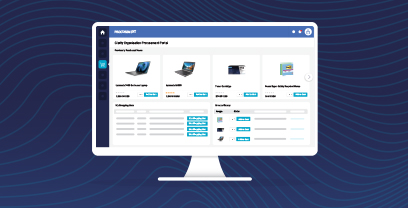Purchase orders are essential in procurement and business operations, ensuring accuracy and accountability. They act as formal agreements between buyers and suppliers, detailing purchases and preventing disputes or miscommunication.
This article will cover the basics of purchase orders, the different types of purchase orders, their operational process and their importance in business.
What Is a Purchase Order?
A purchase order (PO) is a formal document from a buyer to a seller, detailing a purchase transaction. Often confused with a purchase requisition (PR), which is an internal request for approval, a PO details the transaction with the supplier. It contains essential information like product types, quantities, prices, delivery dates and payment terms. Once accepted, it becomes a legally binding agreement.
POs are crucial for clear communication in business transactions, reducing misunderstandings and enhancing procurement efficiency, inventory control, budget management and supplier relations. However, many organizations still rely on manual PO processes, leading to inefficiencies; a 2022 Hackett Group Purchase-to-Pay Performance study found that 61% of organizations experienced operational inefficiencies due manual processes.
While Purchase Orders initiate transactions, invoices request payment after goods or services are delivered, completing the accounts payable process. Understanding the relationship between POs and invoices is vital for optimizing the purchase-to-pay process.
Types of Purchase Orders
Different types of POs are tailored to meet a variety of procurement needs. This overview explores the distinct types and highlights how a digital purchase order management system can streamline and optimize processes..
Standard Purchase Orders (SPO)
Standard purchase orders are the most common type and are typically used for one-time purchases. These POs include detailed information such as item descriptions, quantities, prices and delivery dates.
Standard purchase orders are ideal when the buyer has a clear understanding of the purchase requirements and needs to make a single, specific purchase. Since they are used for individual transactions, each standard purchase order is unique and stands alone from other POs.
Planned Purchase Orders (PPO)
Planned purchase orders are used for anticipated purchases where exact timing or specific details are not yet finalized. Unlike standard purchase orders, PPOs provide a framework for future transactions, allowing businesses to plan for expected purchases without committing to a specific delivery date.
Once the details are confirmed, a release is issued under the planned purchase order to finalize the transaction.
Blanket Purchase Orders (BPO)
Blanket purchase orders are used for recurring purchases over a period of time, often with the same supplier. They cover multiple orders over a set duration and are ideal for businesses that require consistent, ongoing supplies.
BPOs streamline procurement processes by reducing the need to issue a new PO for each transaction, saving time and reducing paperwork. They typically include a maximum spending limit to help the organization manage costs and stay within budget.
Contract Purchase Orders (CPO)
Contract purchase orders are legally binding agreements that are established before the specific order details are known. They’re used when the buyer and seller agree on the terms and conditions of a purchase in advance, but the exact details – quantities, delivery dates, and others – are determined later.
CPOs are often used in complex procurement scenarios where long-term supplier relationships are involved, and they provide a solid legal foundation for future transactions.
Digital Purchase Orders (DPO)
Through advanced technology like digital purchase order systems, businesses can automate and streamline the entire PO process, from creation to approval and tracking for any type of Purchase Order. DPOs reduce the risk of errors, enabling faster processing and providing real-time visibility into procurement activities.
By transitioning from manual to digital PO systems, businesses can better manage their standard, planned, blanket and contract purchase orders, ultimately reducing costs and improving overall efficiency.
What are the different Steps in the Purchase Order Process
The purchase order process is a structured workflow that ensures procurement activities are efficient, transparent, and aligned with organizational goals, encompassing everything from initial requisition to payment.
- Purchase Requisition (PR)
It all begins with a PR: a formal request made by a department or employee to procure specific goods or services. The PR outlines the details such as quantity, specifications, and justification for the purchase.
- Purchase Order Creation (Req to PO)
Once the PR is approved, the procurement team converts it into a Purchase Order (PO) – a formal contract between the buyer and the supplier, outlining details such as product descriptions, quantities, agreed-upon prices, and terms of delivery.
- Approval
Before the PO is sent to the supplier, it undergoes an Approval Workflow. Different departments or individuals, such as budget holders or managers, review and approve the PO to ensure compliance with company policies and budgetary restrictions.
- Dispatch PO to Supplier
After obtaining the necessary approvals, the PO is dispatched to the supplier. This can be done via email, electronic procurement platforms, or other agreed-upon communication channels. The supplier reviews the PO and confirms the acceptance of the order.
- Receipt & Inspection
Once the goods or services are delivered, the receiving team conducts an Inspection to ensure everything matches the PO in terms of quantity and quality. Any discrepancies or damaged items are recorded and communicated to the supplier.
- Invoice Matching
After the goods are received, the supplier sends an invoice. The finance team then performs an Invoice Matching process, where they compare the invoice with the PO and the receipt record to ensure accuracy. This ensures the invoice reflects the agreed-upon terms and delivered quantities.
- Payment Processing
During this step, the finance department processes the payment according to the payment terms outlined in the PO.
Streamlining the purchase order process can significantly reduce procurement costs. According to The Hackett Group, companies can cut procurement costs by up to 30% through better procurement management, which includes optimizing the purchase order process.
For those looking to delve deeper into optimizing their procurement processes, including how purchase orders fit into the broader procurement strategy, it’s worth learning more about the purchase-to-pay process.
Benefits of a Digital Purchase Order Management System
Implementing a digital purchase order system can transform procurement by enhancing efficiency, reducing cost and improving overall operations.
One crucial advantage is the reduction of errors and manual tasks. Through automation, organizations can minimize human mistakes from data entry, ensuring greater order accuracy and fewer costly disruptions. Digital systems accelerate processing through automated approvals and instant dispatch, enabling quicker responses to procurement needs.
Enhanced visibility is another key benefit. Real-time tracking and status updates allow procurement teams to monitor orders and address issues promptly, ensuring greater reliability. A robust digital system integrates seamlessly with other procurement and financial platforms, synchronizing data r to streamline inventory, budget, and supplier management.
By automating routine tasks, these systems save time, allowing teams to focus on strategic activities like supplier management and cost optimization rather than administrative work.
According to Ardent Partners, a 1-2% reduction in procurement costs can have the same impact on profitability as a 10% increase in sales. This statistic further underscores the importance of streamlining procurement processes through digital solutions.
Explore how e-procurement can benefit your business with our e-procurement datasheet on digital procurement solutions.
How Ivalua Can Automate the Purchase Order Process
Ivalua’s e-procurement platform simplifies every step of the PO process, and enables procurement teams to manage all aspects of spend with all suppliers through one unified platform. Key features include:
- Complete automation of the Purchase Order process, which reduces manual tasks and errors, speeding up the procurement cycle.
- A user-friendly way to create POs in just three clicks, allowing teams to focus on strategic activities.
- Smart 4-way matching for invoicing, ensuring alignment between the purchase order, receipt, invoice and contract, thus preventing discrepancies and overpayment.
- Customizable approval workflows to automate reviews
- Real-time tracking provides for visibility into order status
- Powerful reporting and analytics tools enable businesses to track metrics and optimize procurement strategies through data-driven insights.
What’s more, the platform integrates seamlessly with existing ERP systems, synchronizing procurement data for better inventory and budget management.
According to Forrester, “Ivalua has strength across its entire suite, particularly in source-to-contract. Ivalua’s strategy is to help clients manage all their spend with all their suppliers via one unified SVM platform, underpinned by transparency, adoption, efficiency, and collaboration.”
To see how Ivalua can transform your procurement process, watch our procure-to-pay software demo.
Assess and Improve Your Current PO Strategy
Embracing e-procurement and PO management software like Ivalua’s could be the key to unlocking greater efficiency and cost savings in your procurement operations, ultimately equipping your business with the essential tools to optimize procurement and drive substantial improvements across your supply chain. Now is the time to assess your current purchase management strategy and determine whether manual processes are slowing you down or creating visibility and integration issues.
Explore The Forrester Wave™: Supplier Value Management Platforms, Q3 2024 report on to learn more about the transformative potential of Ivalua’s platform.




